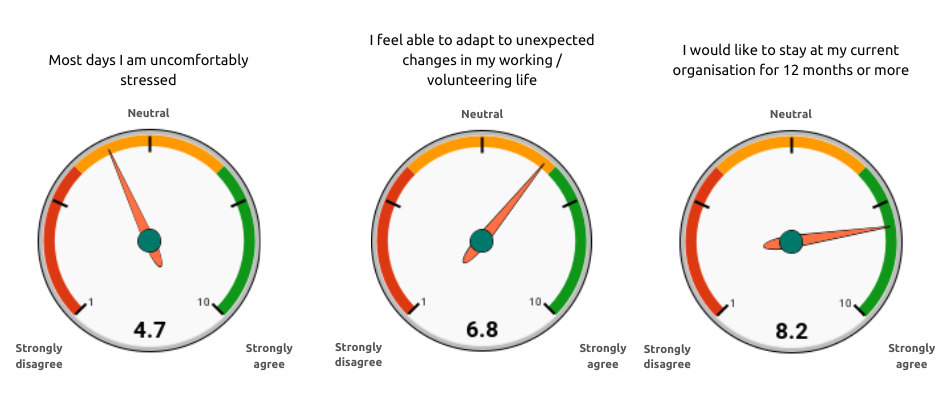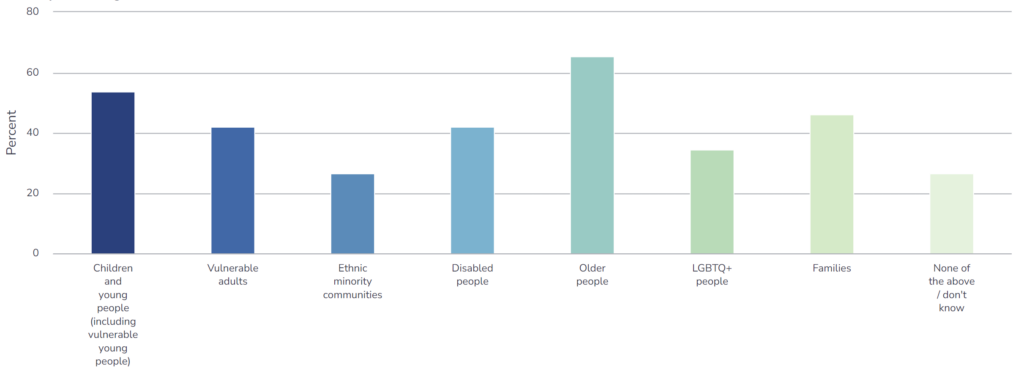Results from March 2024 Panel Research
In March 2024, 266 UK Heritage Pulse panel members responded to a survey which asked a series of questions about their organisational and individual resilience.
The questions repeated those we asked in August last year and can be compared to demonstrate changes in the sector. Respondents whose organisations receive regular local authority funding also answered a set of questions on the impact of potential cuts and uncertainty of future funding.
Sector health check
The first section of questions explored organisational confidence and their place within the sector. This is the second time we have asked these questions, so can track the responses compared to August 2023.
Impact and opportunity: Significant decrease in respondents’ confidence in their organisation’s ability to adequately care for its area of heritage, despite feeling valued by the general public and the sector.
- The most significant change since August 2023 is in respondents’ confidence that their organisations can adequately care for its area of heritage or collection. In August 2023, 57% of respondents agreed. This has decreased by 14% to 42% of respondents. The biggest difference is in organisations with over 10 employees, where agreement levels have dropped by 24%.
- 3 in 4 respondents agreed that their organisation, or the heritage it cares for, is valued by the wider society, but this has decreased by 6% compared to August 2023. 74% felt their organisation is respected by the sector.
- 59% are confident about the future of their organisation, a decrease of 7% compared to August 2023. This drop in confidence is particularly seen in organisations with more than 10 staff, whose confidence has dropped by 9%.

Organisational resilience: Increased challenges in recruitment of staff and volunteers, with responses also showing increased impact on ability to plan due to reduced income and increased costs.
- Only a third of respondents (33%) said their organisation was currently able to recruit and train new volunteers and staff as needed with minimal impact on their operations. This has decreased from 39% in August 2023.
- 41% agreed they could adapt to challenges around reduced income or increasing costs while 29% disagreed with that statement. This is fairly consistent with August 2023 results. Organisations with a turnover of less than £1 million feel slightly more able to adapt.
- Less than half of respondents (44%) agreed with the statement ‘My organisation has the information it needs to plan for the medium term (1-3 years)’ a decrease of 6% since August 2023.

Individual resilience: Despite an increase in stress levels over the last 6 months and decreased ability to adapt to unexpected change, the majority of respondents want to stay at their current organisation for more than a year.
- More than 1 in 4 (28%) said they were uncomfortably stressed most days, a 5% increase compared to August 2023.
- 60% of respondents said they would be able to adapt to unexpected changes in their working / volunteering life.
- Despite this, 78% of respondents said that they would like to stay at their current organisation for 12 months or more, with 56% strongly agreeing with this statement.

Local authority funding cuts
The second part of the survey asked organisations who are funded by local authorities to tell us about the impact of cuts – or potential cuts – to their funding. 49 respondents said they receive regular local authority grant funding and were asked to respond to these questions.
Organisations report a mixed funding picture with short term funding agreements and many seeing at least some reduction in funding
Most of the local authority funded organisations have a current funding agreement of 1 year or less. Just 20% of respondents have agreed funding for 3 or more years. When asked about how their funding had changed over the last decade, 38% said it had either remained at a standstill, or reduced by 25% or less. Only 10% reported a reduction of more than 50% over the last 10 years. However, 1 in 4 reported a mixed picture with funding volatile.
However, 38% of organisations only rely on local authority funding for 10% of their income and the majority (60%) say less than 20% of their funding comes from local authorities. Only 1 in 5 are getting 70% or more.
Some organisations also reported receiving in-kind support from their local authorities. Examples of this included the low-cost use of facilities like meeting rooms and free office space. Others stated they’ve had access to general services such as finance, IT, legal, and HR, and professional advice.
Majority of organisations are not clear on their local authority’s plans for future funding
Organisations await decisions on future support or funding from local authorities. Some are expecting imminent funding cuts and are therefore exploring the implications of this:
“We receive funding from several local authorities and have been told that funding is at risk going forward by several of them.”
Respondent
“A number of our members are funded from local authorities. What we are seeing and hearing is that their budgets are being significantly reduced which in turn restricts their ability to sign up to our membership and participate in our paid-for events. Equally significant is the impact to the sector as a whole with heritage management staff roles under threat at a number of LAs.”
Respondent
Others are simply unaware of the direction the decision might go, but are aware of the potential impact:
“Entire granting schemes appear and disappear with very little warning.”
Respondent
“More cuts seem likely and many small Community Groups will fold.”
Respondent
Core running costs and community activities most likely to be impacted by cuts
When asked what their local authority funding is used to support, the areas which came out more clearly were: core running / operating costs (59% of respondents), activities delivered for/with the local community (57%), conversation of a collection, site or environment open to the public (39%) and promotion their locality as a visitor destination (28%).
A third of respondents said none of these activities had already been impacted by cuts, but two areas in particular were cited as having already been impacted: core running or operating costs (37%) and activities delivered for/with the local community (33%).
Which of these activities, if any, has already been impacted by cuts to local authority funding?

Looking to the future, when asked how any future cuts might impact their activities, again core running costs and community activities are the two most impacted areas.
33% of respondents said their conservation of a public collection, site or environment would be impacted and 24% said their ability to promote their locality as a visitor destination would be affected. 15% expect funding cuts to impact their ability to provide community facilities (e.g. warm banks, public toilets, refuge).
Many respondents are preparing for the implications of these funding cuts, making or planning cuts to services and activities or increasing prices:
“We may have to increase our charges to the community users of our facility.”
Respondent
“Potential of reduced opening hours and staff redundancies, as well as reduction of activities and conservation/maintenance work.”
Respondent
“We won’t be able to do the added benefits to the local community, which brings in income to the local area, supports mental health provision, and supports local low income families. Cultural activities will be curtailed, and opportunities for young musicians restricted.”
“They are already felt, because we cannot adequately plan ahead.”
Respondent
“Greater reliance on external non-governmental funding for supporting community projects. Unsure of the timeline.”
Respondent
Older people and families with young children most likely to be impacted by cuts to community activity
Respondents were asked which groups of people will be most affected by cuts to local authority funding. 65% said older people, 54% said children and young people (including vulnerable young people), and 42% said vulnerable adults will feel the biggest impact.
Which of the following will be affected by cuts to local authority funding?


